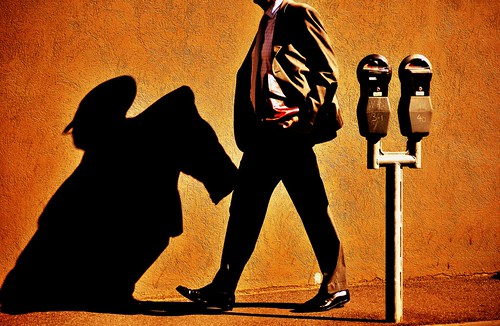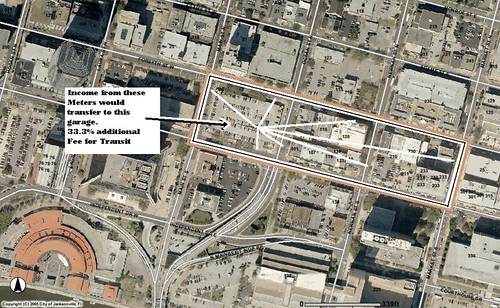
Many Sunbelt cities share the same plague. We have gone from dense compact streetcar communities, to sprawled auto scale suburbia. This disease has eaten away the historic fabric of our downtown's, collapsed real estate values, and relegated transit to a poor persons accommodation. To fight the early compact parking famine, meters were installed to give the city some control over parking abuse and to raise much needed income for city improvement projects. This phenomenon almost without fail killed the downtown retail, restaurant and club trades. It sent the shoppers scurrying for the suburbs where they had acres of free parking and well lit, heated or air conditioned shopping comforts.
To fight this trend, some cities, Jacksonville, one of the leaders among them, started a program to raze old buildings and install new multi-level parking garages. The meters stayed at the curbs, and the income kept rolling in, but the ratios of expense to income grew worse with each multimillion dollar garage. The garages had another effect on downtown, they stole away the office workers that previously had walked to and from their posh work stations by making the auto-office connection seamless. Transit agencies, most all centered around the central city were no match
for what now seemed an automotive slam dunk play.
Something funny happened on the way to autotopia, holes Begin to appear in downtown's all across the nation. Big holes, whole blocks swallowed by vacant lots, cheap parking, and pay by the hour vendors. While some Cities retained their close in streetcar business districts, the core was rotting from the inside out. The dearth of people and falling prices, plus the homeless that moved in on the vacant land now caused even more low or zero income people to flood the formerly prosperous meccas.
Jacksonville is VERY luck to have held fast to it's close in streetcar developments such as San Marco, San Jose, Springfield, Riverside, Avondale, 5-Points, St. Nicholas, A. Phillip Randolph, Fairfax, Murray Hill, Durkeeville (Historic home of the American Negro League Baseball Teams), Moncrief as well as Park and King. But as the City core became more and more a bland cement wall or glass towered giants, the doors along the street became fewer and fewer. Sprawl looking to escape the homelessness, poverty, and illusion of unsafe conditions, leapfrogged the old Streetcar neighborhoods and dove into suburban sprawl.
How does Jacksonville stack up to other cities? How do we look compared to your town? Imagine a booming Sunbelt City with the above core conditions sprawling over 860 square miles. That my friends is our City, and I wouldn't try walking to your corner grocer or hardware store unless your down for some brutal miles.
I'd like to offer a solution that might at first take, seem over simplistic. Trust me, in application it is simple, but the results will be invigorating.
To set the stage for this conversion we must first get an audit of all available parking in the core of the central city, at least everything covered by metered parking. On the one hand we want to know EVERY garage space, or surface parking space in the city, their count, occupancy rates, and any available space. Next we need an audit of the meters on a block by block, street by street, and east side, west side, north and south side, total average monthly income per block per side.
Step three is to take the garages and surface lots, and assign each of them a territory, naturally the 900 car garage is going to have a larger territory then a 230 car surface lot. The Territory's should be balanced so that each covers a percentage of the metered spaces.
The parking meters are then and forever removed and replaced by hourly, parking restrictions. These parking restrictions can flex according to local need. The average income per metered space is directly transferred as a fee to the surrounding garage or surface lot, again according to usage and revenue. Meters that average $3 dollars per day will obviously transfer more fees within their district then an area where meters average .25 cents per day.
So far we've explored how to retain both the income and hourly parking enforcement as well as remove the meters, making downtown more people friendly.
This opens a door to add a small percentage to all of these fees, depending on the total amounts transferred, anywhere from a few percent, to a solid 33%, could be tacked onto the former METER income. To prevent a tax revolt, it wouldn't be fair to arbitrarily zap the former parking spaces with a fee increase based on the spaces former income. This revenue which could amount to several thousands of dollars daily over and above the money needed to keep parking enforcement intact, would go directly into the construction or reconstruction of Streetcars, LRT, Trolley Bus, and any other fixed guideway transit.
The final incentive for this is beyond even the recovery of our downtown retail marketplaces, it's all of the above, urban cores that beg work, play, and live.
The personal incentive is as easy, anyone not wanting to see their monthly parking space rental go from $35.00 a month (yes, over building has cause very low prices in the Sunbelt - but these numbers are examples only) to perhaps $50.00 a month, will be offered a month long transit pass as a new choice rider, at a discounted $40.00 a month. This is an incentive that could continue as long as they use transit or if it proves extremely popular, it could have a time limit on it.
So what did this plan do?
Got rid of the meters
Retained all of the income
Added a fee for transit to build fixed route transit
Retained all parking enforcement employees
Slight garage parking fee increase
Gives the city more oversight into parking construction
Builds incentives to return retail, work, play, live, downtown
Invites new Choice Riders to try Mass Transit
It's way past due, lets do something today.
Robert Mann: Jacksonville Transit Blog

























